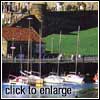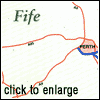|
The Kingdom of Fife
During the lead up to 'regionalization' of Scotland's
old counties in 1975, the 'Kingdom of Fife' fought hard to avoid being swallowed
up by Tayside to the north and Lothian to the south. If anything, this helped to
reinforce the area's sense of identity, both to its residents and outsiders. Its
geographic position is unique and probably contributes to this character, thrust
into the North Sea and detached, north and south, by the rivers Tay and Forth.
 With such attractive jewels as St Andrews, the East Neuk and
historic Dunfermline, Fife's potential as a tourist destination is now its greatest
asset and, as the 'Home of Golf', it has almost mythical status with golfers around
the world. Historically, like other parts of the nation, it has held the mantle as
hub and focus of political and ecclesiastical life for long periods with Dunfermline
and St Andrews being the major historic centres. With such attractive jewels as St Andrews, the East Neuk and
historic Dunfermline, Fife's potential as a tourist destination is now its greatest
asset and, as the 'Home of Golf', it has almost mythical status with golfers around
the world. Historically, like other parts of the nation, it has held the mantle as
hub and focus of political and ecclesiastical life for long periods with Dunfermline
and St Andrews being the major historic centres.
Touring through Fife, you will notice a distinctive
style to much of the architecture, especially in the charming coastal villages. Their
cottages and most of Fife's older buildings reveal strong links with the Low Countries
where sixteenth century trade, before links with the Americas were established, was
a key element to Scotland's economy. Ships loaded with wool, cloth, timber and fish
were sent across the North Sea and often returned with the distinctive red roofing
pantiles loaded as ballast.
The views approaching Fife from the road or rail bridges
are stirring, particularly looking down on the village of North Queensferry which
appears in miniature from the bridge spans passing high above it. To investigate
further, leave the motorway at the first exit in Fife or, if you are enjoying a rail
excursion from Edinburgh, disembark at North Queensferry. The village was the centuries-old
northern terminal for a ferry crossing established by Queen Margaret to carry pilgrims
to nearby Dunfermline. With its other landfall at South Queensferry, this service
lasted for nearly 800 years until the road bridge was opened in 1964.
Apart from the wonderful views across the Forth and
excellent camera angles of the marvellous engineering feat of the Forth Bridge, North
Queensferry's latest attraction is Deep Sea World, a giant aquarium complex housing
the world's largest underwater viewing tunnel.
 Created next to a former quarry, this nautical safari takes
you beneath one million gallons of sea water through a sturdy transparent tube to
see, at close quarters, most of the creatures you would find in British coastal waters.
Wriggling through the rocks and swimming overhead are 100 different species native
to Scottish waters including lobster, squid, octopus, eel, salmon and sea trout.
A 'people-mover' conveyer belt transports visitors slowly through the main tank while
upstairs there are more aquariums, educational exhibitions, a coral reef display
and cafe. Created next to a former quarry, this nautical safari takes
you beneath one million gallons of sea water through a sturdy transparent tube to
see, at close quarters, most of the creatures you would find in British coastal waters.
Wriggling through the rocks and swimming overhead are 100 different species native
to Scottish waters including lobster, squid, octopus, eel, salmon and sea trout.
A 'people-mover' conveyer belt transports visitors slowly through the main tank while
upstairs there are more aquariums, educational exhibitions, a coral reef display
and cafe.
Follow the A985 from North Queensferry via Inverkeithing.
The sixteenth century burgh of Culross (pronounced Koo-riss) is a medieval hamlet
set amongst the industrial Upper Forth Estuary. Antiquated cobbled streets, still
used today by its modern residents, climb through the hillside village bordered by
excellent examples of terracotta pantile and white-harled cottages.
|


